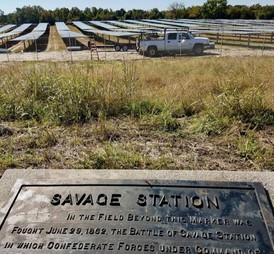
(This image from the Times-Exponent shows what was planned for the Rapidan Front area of our county just south of Refuge Farm. It was proposed as 1,800 acres of black “green” glass, which means it is “renewable” in that it must be replaced every thirty years or so.)
We are fighting again here in Culpeper County. As you have gathered from my scattered ruminations about Refuge Farm, we live in the middle of the most marched over, camped on and fought over chunk of land in America’s Civil War.
Our land was the pivot point in the greatest struggle in our history. General Lee’s March to Gettysburg started here after the winter of 1862-63. Grant and his boys were here the next cold season, preparing for the Overland Campaign that took the defenses of Richmond and ended at Appomattox Courthouse.
The two winters of occupation left scars that took generations to subside in our rich soil. Along the way, the Dominion Power people ran high-capacity electric lines up the ten-by-twenty mile historic corridor, and there began the latest fight on these verdant fields. I am only a stray art of it, but the idea that an industrial-grade power installation would buttress my trees spun me up.
Local historian Clark B. Hall summed up the history of the rolling green on which Refuge Farm proudly- and anonymously- sits. In the Civil War, major actions were fought within a narrow, 10-mile-wide valley plain stretching south 20 miles from the Rappahannock River at Rappahannock Station (modern Remington) to the Rapidan River at Rapidan Station.
The battles included the ones at Cedar Mountain; Kelly’s Ford; two at Brandy Station, and Rappahannock Station. From 1862 to 1865, “more Civil War campaigns opened in Culpeper than any other county in the country, including 2nd Manassas, Chancellorsville, Gettysburg, Bristoe Station and the Overland Campaign. More troops, from both armies, camped in Culpeper than anywhere else in the country.”
Given the tumult of social order these days, When I discovered what was proposed for industrial-scale development just south of my property line, I was moved to write the local newspaper, expressing my objection to turning this part of Battle Alley into a Chinese-manufactured array of black glass 35 times larger than my little rustic place. My little opinion piece prompted the response from Maroon Solar that Mr. Hall describes below, in part:
“Maroon project developer Louis Iannone wrote: “[W]e believe Maroon Solar will go unnoticed by the vast majority of Culpeper citizens.”
Mr. Hall has skin in this game, since he has worked much of his life to preserve this little bit of land on which so much of our nation’s history was decided. The County Planning Commission rejected the Maroon Solar project as not meeting the needs of its citizens. In fact, they rejected it twice. The problem was the Board of Supervisors, for which the Maroon People dangled millions in taxpayer funded benefits. He went on to say this at the Supervisor’s meeting last Tuesday:
“Now, how about that? We won’t notice? Easy for him to say, while this patronizing fellow sits 500 miles away, in North Carolina. No, believe me, we will “notice.” As one who has worked over three decades to help protect Culpeper’s Civil War battlefields, I would love to hear a county official—once and for all—respond to Maroon Solar’s all-too-typical developer disdain of our local traditions and prerogatives by asking, “Who are you to lecture us about what is best for our county, its citizens and its unparalleled historic landscape?”
“Developers have no moral or legal standing to preach to us, as Culpeper citizens, what is best for our community. We are uniquely capable of wisely deciding these vital matters for ourselves. I hope we are wise enough to see Maroon for what it is–nothing more than a sleight-of-hand tax scam designed to make money, at the expense of our incomparable natural and historic assets.”
The enormous Maroon solar project is part of the extraordinary green windfall being distributed for things that could not work without subsidies paid for by the taxpayers. You- and me. He went on to ask:
“Shall we meekly stand by and let others destroy a major landscape component of our historic battle corridor? No, we should not.”
I have not met Mr. Hall, but I support his position. Each morning when I hear the whistles of the railroad that runs on the tracks my G-G-G Grandfather helped lay I feel a shiver. That is to say, family shovels have been in this soil since before the Armies came to visit. And fight.
Mr. Hall made a reasoned but passionate address to the Supervisors meeting. Thirty-one citizens joined him to speak against the project. Surprisingly, the Supervisors agreed with them. They voted unanimously to reject the proposal.
As you have gathered, a variety of armies, some conventional and others flush with cash provided in part by you, will be back. Dominion would like to use their lines. Maroon, and others, would like to have us subsidize a vast shiny array of glass panels to provide some electricity when the sun shines. We have seen the consequences of that in Texas, when weather made its own vote and froze the windmills and obscured the solar arrays.
The armies of commerce will be back. This is Battle Alley, after all. But for now, the people who live here had a chance to speak on the latest engagement in an old fight. I am sure they will return. But for now, it is time to celebrate before they reform for battle. Again.
Copyright 2021 Vic Socotra. Mr. Clark Hall courtesy of Culpeper Times-Exponent
www.vicsocotra.com
